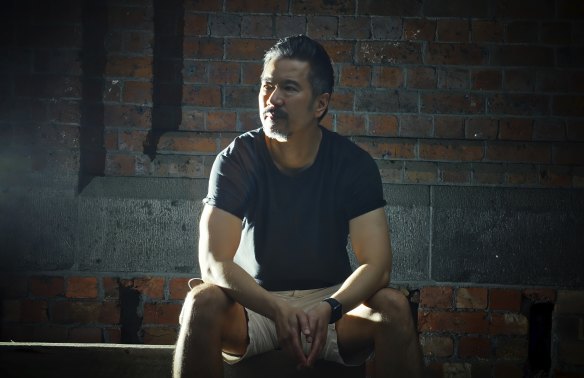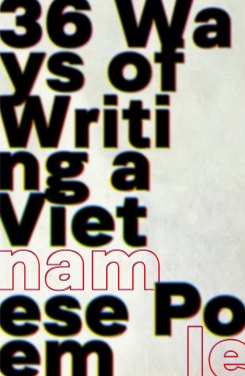Nam Le returns with poetry, but the question is: Where’s his novel?
By Jason Steger
When Nam Le was at primary school, his teacher read that rollicking narrative poem The Highwayman by Alfred Noyes to the class. To the little boy who arrived in Australia as a babe in his parents’ arms after they fled Vietnam on a refugee boat, it had a profound impact.
“The rhythms, they found their way deep into my body. And I was writing imitations of The Highwayman almost immediately. I think that’s what I did for ages,” he said. “I was reading whatever I could find ... whatever was available, which was mainly sort of the western English canon, and just soaking it in, revelling in it, and copying it.”

“I probably would never have imagined that 20-plus years on, these issues would remain so pressing and so alive,” Nam Le says.Credit: Luis Enrique Ascui
For the longest time, Tennyson was his totem poet: “I think it’s because of his ear, because of his rhythms. He just had this incredible intuitive sense of how to flood the frequency that I was operating on.”
You won’t find any Highwayman-like lines in 36 Ways of Writing a Vietnamese Poem, somewhat astonishingly Le’s first creative work since The Boat, his book of short stories that dazzled readers, reviewers and prize judges when it came out in 2008. (He did also write a short book about David Malouf for the Writers on Writers series in 2019.)
36 Ways is a sort of taxonomy of the possibilities of language when applied to a particular poetic task. In Le’s case, that of writing in a second language about that language itself, about his homeland, the diasporic experience, trauma, racism, power and so much more. It is a sort of ars poetica, using the form to write about the multitudes of the form itself. (Reminiscent in a way of the opening story in The Boat, which among other things is about writing a story.)

Credit:
Le says there has been an expansion of the space of what a “so-called Vietnamese or ethnic poem” might look like. And so he considers the book, which cites Emily Dickinson’s famous “Tell it slant” line in one poem, a warning guide, a way-finding guide and “an ode to the various possibilities and limitations of expression”.
For someone for whom English is not their first language, “there is a sense of continual reckoning with the language and with the ways in which it’s deployed and sometimes instrumentalised to keep you in your place, or to keep you out”.
As he writes in [2. Invocative/ Apostrophic]: ” ... Your language your leash ... Whatever I write is/ Vietnamese. I can never not – You won’t let me not – Lick the leash or bite it ...” So he is alive to the tyranny of English, one that’s steeped in the history of conquest, imperialism, violence and miscegenation.
But, at the same time, he feels welcomed and at home in the English language. He both delights in it and is in awe of it: “There is a sense of capacity and openness to osmosis and outside input that I think is extraordinary. It’s so adaptable and flexible and polysemous. It’s way bigger than I could ever get a grip on, which is exciting to me.”
His spoken Vietnamese is not fluent, and he doesn’t read it or write it. But “I have the rhythm and tone of what I would call my mother tongue [the family spoke Vietnamese at home], my native language, and I can still feel that playing itself out when I express myself in English whether I’m speaking or writing.”
He still has lots of family in Vietnam but hasn’t been there for many years. His relationship with the country is complicated by what he calls reticences on all levels
“And it’s politically complicated in a way. Going back to Vietnam you are still being confronted with some of the after effects of the reasons why my parents left back in the ’70s.”
The Boat was published in Vietnam, but parts of it were changed without Le being consulted, and he doesn’t think it likely 36 Ways would be translated into a different language. “It would be a completely different beast, which is kind of exciting if it were to happen.”
The earliest germ of the material in 36 Ways came more than 20 years ago. The concerns with representation and identity eventually seen in The Boat’s seven stories were agitating Le well before. “I probably would never have imagined that 20-plus years on, these issues would remain so pressing and so alive. I think I had a naive hope that we were sorting through some of these ... I don’t think anyone would say that’s the case.”
He largely wrote poetry before concentrating on prose when he joined the famous fiction program at Iowa Writers Workshop. Doing so, stripped away any excuses he had not to write: “There was a positive coercion where you were kind of announcing ‘I’m going to try to be a writer’, which from my upbringing in Australia was something that I kept under cover.”
36 Ways, he says, was never meant to be a book. He was writing a shortish piece for the 25th anniversary edition of Watermark, an anthology of Vietnamese American writing. Doing so brought up many of those ideas he had been thinking about and jotting down for years.
It seems not all his publishers were enamoured with the idea of a book of poetry appearing while they had been expecting his long-anticipated novel. Le had to fight for the book, although not with his Australian publisher he’s quick to point out.
“And that has felt really in tune with what the book is doing too in as much as it’s me fighting for authority, for expressive authority, for cultural permission, for the fullness of selfhood and interiority and possibility.”
But what about that novel? Since The Boat, many readers have been licking their lips at the prospect of more fiction from Le. He started it when The Boat appeared in 2008, and is quick to point out that it’s not finished. But he’s still excited by it because if he weren’t, that would be “the death knell for where I’m going”.
And even before The Boat he had abandoned a big novel. “That wasn’t without a painful and drawn-out period of trying to salvage it, trying to streamline it or change it into something that I could stand behind. I have zero regrets about dropping that book as I don’t consider my body of work as only the things that have been published. So for me that book is really important in my personal reckoning and corpus.”
Now the “new” novel is asking him to reckon with it in a way, he says, that feels ever more tricky and difficult. “That’s where the charge is, I guess, and that’s what’s interesting me.”
So, I say, dare I ask ...?
“You daren’t,” he says immediately. “I hope that it’s on the sooner side rather than the later.”
Nam Le is a guest at Sorrento Writers Festival (sorrentowritersfestival.com.au), Melbourne Writers Festival (mwf.com.au) and Sydney Writers’ Festival (swf.org.au). 36 Ways of Writing a Vietnamese Poem is published by Scribner at $26.99.
The Booklist is a weekly newsletter for book lovers from books editor Jason Steger. Get it delivered every Friday.